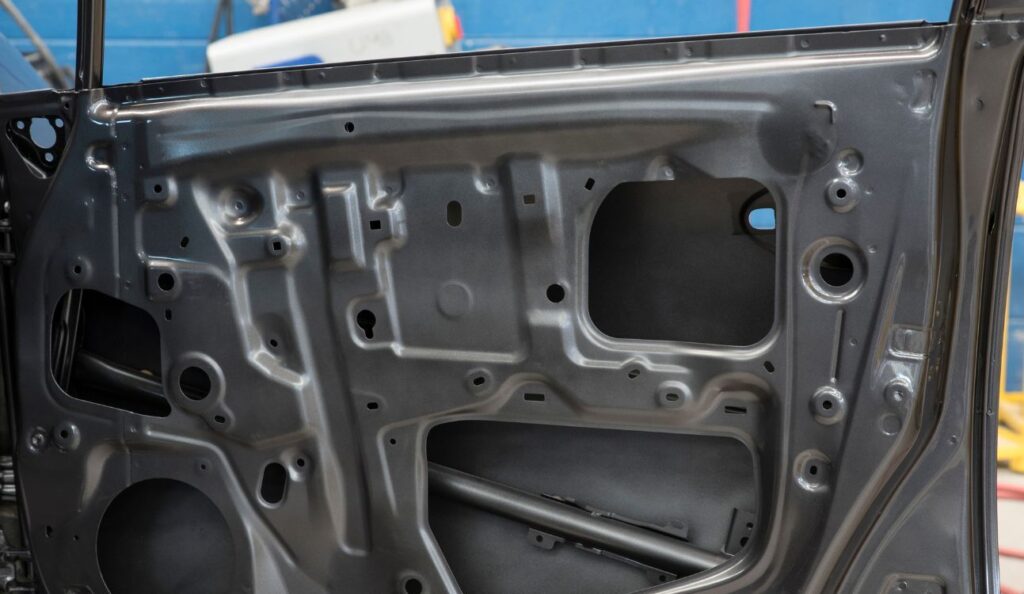
In stamping, process control is crucial for ensuring product quality and consistency. One of the key tools used for process control a reference panel system.
Common Issues in Stamping Process Control
Consider this situation: A door outer has been running well for months. Then, seemingly out of the blue, splits begin to appear in the expansion hole. You look at the trim edge condition and don’t see any heavy burrs or rollover, and the shear-to-break ratio looks correct, but it is difficult to tell. Unsure what to do next, you decide to sharpen the cutting steels and try again. Unfortunately, that does not solve the splits. Unsure what to do next and needing parts, you ask the line to increase lubrication on the panel. Splitting has disappeared, but we have so much material feeding through the bead that we are getting inconsistent geometry in part, and the die needs to be pulled again.
This is a common scenario in many stamping plants. Fortunately, implementing a Reference Panel System (RPS) can be used to help identify and solve these problems the first time.
What Is a Reference Panel in Stamping?
Essentially, a reference panel serves as a stable point of reference for a forming operation. It allows for the capture of the recipe associated with that panel at the time it was hit. The panel is thoroughly analyzed, including features such as high strain conditions, foreign body analysis, and qualitative and quantitative features. This comprehensive documentation enables quick comparison with operational panels to detect any changes or variations that may indicate an unstable panel.
Benefits of Reference Panels in Stamping Process Control
The use of reference panels is advantageous not only for the stamper but also for the entire manufacturing operation. The benefits of reference panels include:
- Facilitating better problem-solving.
- Improving customer relationships (both internal and external) through the use of data and facts.
- Helping to detect and measure changes in the process quickly.
Setting Up a Reference Panel System
To ensure the effectiveness of the reference panel system, a complete data set, including the draw shell, the recipe, a reference blank, a trim scrap template, and other associated templates, is essential. This comprehensive data set is invaluable for analyzing any issues that may arise in the manufacturing process.
Setting up a reference panel system is straightforward, but it requires time. Commonly performed during product launch, a panel is captured during every tool change. We aim for five draw panels taken from five consecutive tool set-ups. During each set-up, all die recipe parameters need to be collected. If all panels collected reach the quality standard required and are verified by the formability lab, we can now be sure that the die recipe is robust enough to handle typical process variables and still produce a good part. Now, when a problem arises we can compare the newly created panel.
Long-Term Benefits of Implementing Reference Panels
The implementation of reference panels can lead to more precise and informed decision-making, helping the forming or stamping operation avoid poor solutions and ultimately eliminating process variation.
While implementing a reference panel system may present challenges, the long-term benefits in terms of improved product quality and process control make it a worthwhile investment. Even if a facility is not currently using reference panels, alternative solutions, such as asking a lab to hold panels or creating templates for critical areas, can still provide valuable data for future problem-solving efforts.
The Value of Reference Panels in Stamping
The use of reference panels in process control is an essential tool for maintaining product quality, facilitating better problem-solving, and ultimately eliminating process variation. The comprehensive data captured through reference panels enables informed decision-making and ensures that any issues in the manufacturing process can be quickly and accurately addressed.
By incorporating reference panels into the manufacturing process, operations can benefit from improved quality, reduced variation, and, ultimately, a more efficient and reliable production system.
Partner with Phoenix for Superior Stamping Process Control
At Phoenix, we understand the critical role that reference panel systems play in ensuring consistent quality and efficiency in sheet metal stamping. Our team of experts is dedicated to helping you implement and maintain robust process control systems tailored to your specific manufacturing needs.
If you’re interested in learning how The Phoenix Group can drive improvement at all levels of your organization, contact us today.


